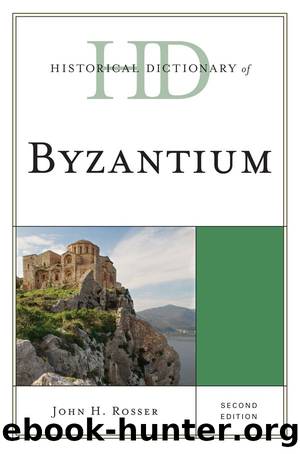Historical Dictionary of Byzantium (Historical Dictionaries of Ancient Civilizations and Historical Eras) by John H. Rosser

Author:John H. Rosser [Rosser, John H.]
Language: eng
Format: azw
Publisher: Scarecrow Press
Published: 2011-12-22T00:00:00+00:00
Hagia Sophia, Constantinople. Facing northeast.
Byzantiumâs greatest church, whose influence was such that subsequent Byzantine churches had one or more domes. However, no Byzantine church was ever again attempted on this scale. Dedicated to Holy Wisdom (Hagia Sophia), Justinian Iâs architects created a church without precedent. Never before had a dome of this size been placed on a square (defined by four massive arches). For western Christians, accustomed to more straightforward basilican church plans, the architecture may have been difficult to comprehend, even enigmatic. However, there is much that is traditional in this church (though not the Ottoman minarets, added after 1453 when Hagia Sophia became a mosque). Its basic plan is that of a Roman basilica, and its centrally planned domed construction were hardly unknown to Roman architecture (e.g., the Pantheon). Nevertheless, the resulting architectural experience differed significantly from churches in the West. Such differences only increased over time. Later in the Middle Ages Byzantine churches appeared dramatically different from Gothic cathedrals. Just as the great religious divide between the eastern and western churches had its origins centuries before the schism of 1054, so, too, did eastern and western church architecture begin to diverge after Justinian I dedicated Hagia Sophia in 537.
Download
This site does not store any files on its server. We only index and link to content provided by other sites. Please contact the content providers to delete copyright contents if any and email us, we'll remove relevant links or contents immediately.
Asking the Right Questions: A Guide to Critical Thinking by M. Neil Browne & Stuart M. Keeley(5575)
Autoboyography by Christina Lauren(5155)
Eat That Frog! by Brian Tracy(4379)
Dialogue by Robert McKee(4272)
Sticky Fingers by Joe Hagan(4060)
Journeys Out of the Body by Robert Monroe(3539)
Annapurna by Maurice Herzog(3398)
Full Circle by Michael Palin(3349)
Schaum's Quick Guide to Writing Great Short Stories by Margaret Lucke(3280)
Elements of Style 2017 by Richard De A'Morelli(3280)
The Art of Dramatic Writing: Its Basis in the Creative Interpretation of Human Motives by Egri Lajos(2945)
Why I Write by George Orwell(2850)
The Diviners by Libba Bray(2841)
In Patagonia by Bruce Chatwin(2830)
The Mental Game of Writing: How to Overcome Obstacles, Stay Creative and Productive, and Free Your Mind for Success by James Scott Bell(2819)
The Fight by Norman Mailer(2799)
Atlas Obscura by Joshua Foer(2759)
Venice by Jan Morris(2496)
The Elements of Style by William Strunk and E. B. White(2415)
